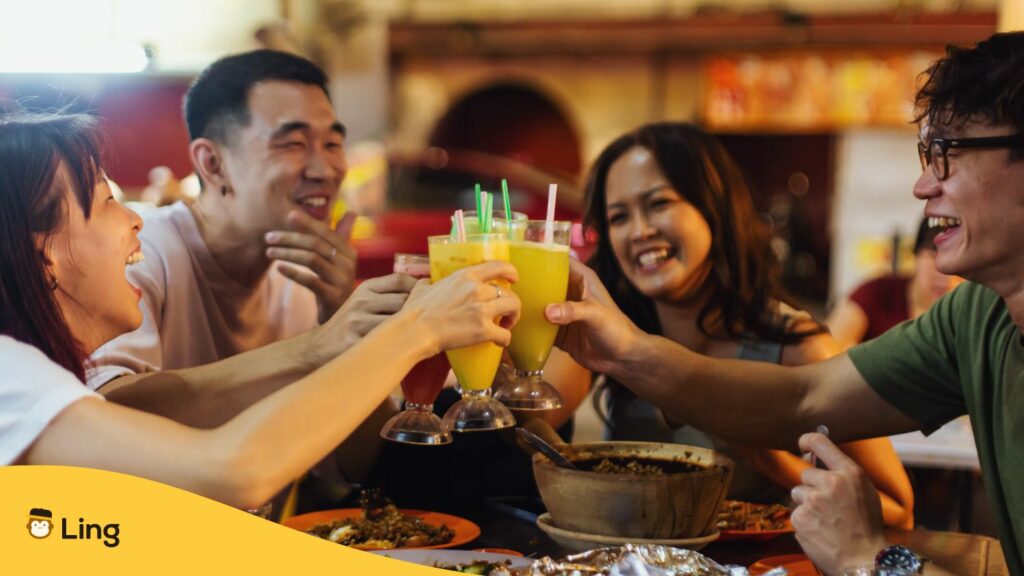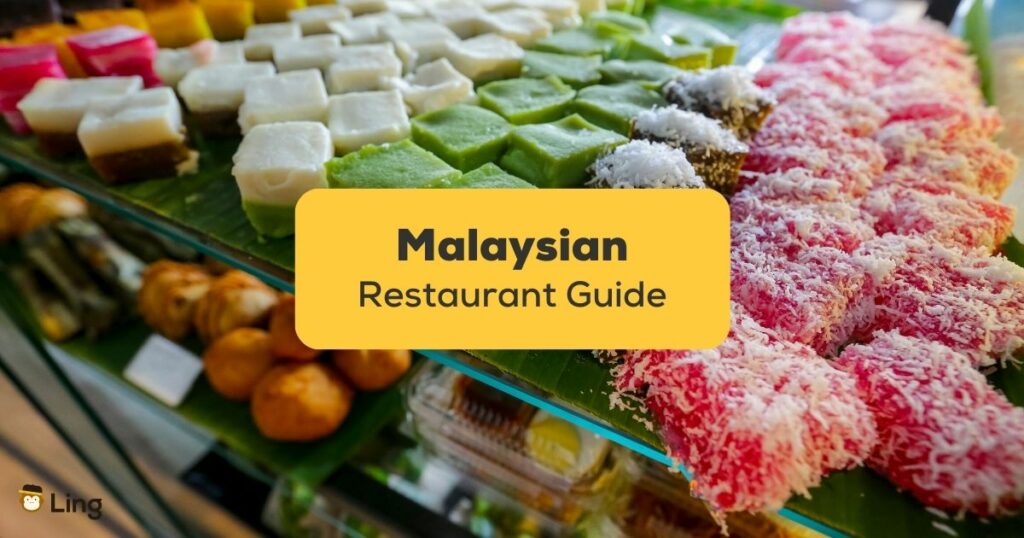Welcome to our “Survival Guide for Any Malaysian Restaurant.” Here, we’ll provide the essential tools for a remarkable dining experience. In this article, you will learn handy phrases to help you order with ease, mouthwatering dishes you want to take advantage of, and important tips on Malaysian dining etiquette.
When all is said and done, you’ll be well-equipped to confidently navigate and enjoy Malaysia’s rich culinary landscape, whether you’re a first-time visitor or a seasoned foodie looking to expand your dining horizons – plus learn some Malaysian language as well!

How To Order In A Malaysian Restaurant
Venturing into the world of Malaysian cuisine is an unforgettable experience, and having a few key phrases in your arsenal can elevate your dining adventure. From requesting recommendations to asking for the check, these phrases will make navigating Malaysian restaurant menus a breeze.
Phrases For Ordering In Malaysian Restaurants
| English | Malay |
| Good day, I’m excited to dine here. | Selamat pagi, saya bersemangat untuk makan di sini. |
| Can I have a menu? | Bolehkah saya mempunyai menu? |
| What drinks do you have? | Minuman apa yang anda ada? |
| Can you recommend an appetizer? | Bolehkah anda mengesyorkan pembuka selera? |
| Which entrée do you recommend? | Entrée mana yang anda cadangkan? |
| I would like it very spicy/spicy/not spicy. | Saya mahu ia sangat pedas / pedas / tidak pedas. |
| I would like to order a bit more. | Saya ingin memesan sedikit lagi. |
| Can you repeat the order for me? | Bolehkah anda mengulangi pesanan untuk saya? |
| Can I have the bill? | Bolehkah saya mempunyai bil? |
| Thank you, you were wonderful. | Terima kasih, anda hebat. |
Best Malaysian Food To Try In A Restaurant
Nasi Lemak
Widely loved for its distinct flavors and rich aroma, nasi lemak is a quintessential Malaysian dish. At its heart, nasi lemak is a fragrant rice dish cooked in coconut milk and pandan leaves, giving it an enticing aroma. The coconut milk lends a rich and velvety texture to the rice, and the flavor of nasi lemak is a delightful combination of creamy, slightly sweet, and savory notes.
What makes this dish truly unique is the combination of side dishes that make it a culinary experience. Traditionally, crispy anchovies, roasted peanuts, a boiled or fried egg, and cool cucumber slices are served with nasi lemak, in addition to sambal, a spicy chili paste. The interplay of textures and flavors makes nasi lemak a beloved Malaysian culinary masterpiece, from the anchovies’ crunch to the sambal’s heat.
Satay
Satay has captured the hearts and palates of food lovers worldwide and is a popular Southeast Asian dish, especially in Malaysia. It consists of marinated pieces of chicken, beef, or lamb skewered on bamboo or metal skewers and cooked over an open flame. Satay’s taste is a delicious fusion of smoky, savory, and slightly sweet aromas, thanks to the marinades of ingredients such as lemongrass, turmeric, and brown sugar.
What makes satay unique is the delicious peanut sauce, a rich and creamy dip that complements the tender and juicy meat with its nutty, tangy, and slightly spicy profile. An irresistible and iconic dish showcasing Malaysia’s dynamic flavors and culinary traditions, satay is often served with cucumber, onion, and ketupat (compressed rice cakes). It’s also very easy to make at home!
Laksa

Laksa is one of the most popular Malaysian dishes, characterized by a harmonious blend of flavors and ingredients, making it a true culinary gem. Typically made with either a spicy curry base or a sour tamarind base, this tantalizing noodle soup is characterized by its rich and creamy broth.
Laksa’s flavor is an intriguing blend of spicy, tangy, and savory notes that blend into a bold and satisfying flavor profile. The variety of ingredients and garnishes found in each bowl makes laksa unique. Common additions include juicy shrimp, tender fish or chicken, crunchy tofu balls, and a variety of fresh vegetables like bean sprouts and pickled cucumbers.
Topped with a sprinkling of fragrant herbs like coriander and mint, laksa is a vibrant and delicious dish that showcases the depth and complexity of cuisine in the Malay peninsula.
Roti Canai
Roti canai is a popular Malaysian flatbread. Known for its delicate layers and irresistible flavor, it is a staple of Malaysian cuisine. This versatile bread is made from a well-kneaded dough of flour, water, and ghee. It is then skillfully stretched, folded, and flattened to create its signature flaky texture. With a crisp exterior giving way to a soft and chewy interior, the flavor of roti canai is a delightful combination of buttery richness and mild spice.
What sets roti canai apart is its ability to pair exceptionally well with a wide variety of accompaniments, from fragrant curries and spicy sambal to sweet condensed milk or sugar. As a result, Malaysians will all have their own ways of eating this excellent food! A comforting and tasty introduction to the diverse and delicious world of Malaysian cuisine, roti canai is often eaten for breakfast or as a snack.
Char Kway Teow
Char Kway Teow, an unapologetically flavorsome Malaysian stir-fry, epitomizes street food indulgence. This plate of culinary magic is concocted from flat rice noodles that are expertly tossed together with a tasty mix of ingredients like shrimp, Chinese sausage, eggs, bean sprouts, and chives.
The taste of Char Kway Teow is an aggressive dance of smoky, savory, and subtly sweet flavors – thanks to the expert touch of dark soy sauce, chili paste, and a hint of sugar. The dish’s unique charm lies in its “wok hei” – the much sought-after smoky aroma and flavor that can only be achieved by stir-frying over a roaring high heat. With each bite offering a delightful medley of textures and tastes, Char Kway Teow is a must-try Malaysian experience that will leave your taste buds craving more.
Teh Tarik
A beloved Malaysian beverage that leaves a lasting impression on those who experience its distinctive taste and preparation, Teh Tarik, often referred to as “Pulled Tea,” is a frothy delight. This frothy delight harmoniously blends strong black tea with creamy condensed milk, resulting in a velvety smooth balance of bitter and sweet notes.
Its most intriguing element is its unique preparation method, which involves deftly “pulling” the tea back and forth between two containers, creating a fascinating flow that aerates the liquid and produces its distinctive frothy top. As well as being a visual spectacle, Teh Tarik is the perfect way to end a meal in any Malaysian restaurant.
Dining Etiquette In Malaysian Cuisine

Use Your Right Hand To Eat
In Malaysia, it’s essential to adhere to local customs and use your right hand when eating with your hands. This cultural practice stems from the belief that the left hand is reserved for sanitary activities, like cleaning oneself after using the restroom. Therefore, to avoid being perceived as disrespectful or rude, enjoy your delicious Malaysian meal using your right hand.
Avoid Touching Someone’s Head
While visiting Malaysia, it’s crucial to be mindful of local customs, including the cultural belief that the head is considered sacred. Touching someone’s head, whether Muslim or not, is perceived as disrespectful and offensive. By avoiding this action, you demonstrate cultural sensitivity, fostering positive interactions and mutual respect with the locals.
Dress Modestly When Dining Out
Dressing modestly when dining out is important to honor the local culture’s well-established traditions and values. Dressing appropriately for the location not only ensures a comfortable experience for you and others. It also promotes a positive atmosphere of cultural understanding and appreciation.
Wait For Your Host To Eat Before You Do
When dining in Malaysia, you must wait for your host’s invitation before beginning your meal because Malaysia is a hierarchical society. This practice shows respect for the host and acknowledges the host’s position in the social structure. Starting to eat before the host does so is considered to be rude and could be interpreted as a lack of respect for cultural norms and customs.
Try Everything On The Table!
In Malaysia, trying a bit of everything on the table is crucial because meals are typically served all at once, creating a shared dining experience. This communal approach to eating encourages guests to sample various dishes, fostering a sense of unity and appreciation for the diverse flavors. By piling one’s plate with a bit of everything served, you can give yourself a taste of the daily life in Malaysia – and please your chef at the same time!

Learn More Malaysian Words With Ling App
Want to learn how to say your compliments to the chef in Bahasa Melayu? Learning the Malaysian language can seem daunting, but there’s one thing that can make learning fun, engaging, and memorable…
Meet the Ling app, the platform to bring your language skills from hero to zero in no time. With lessons in Bahasa Melayu and 60+ more languages, Ling is the perfect place to start your language learning journey. Download the Ling app for free on Android and iPhone today.











